| Designation: | TOS-1 Buratino |
 |
|---|---|---|
| Manufacturer: | JSC Omsk Transport Engineering Plant - Omsktransmash | |
| Product type: | Weapons & Weapon Systems | |
| Name: | Multiple rocket launcher |
Based on T-72 chassis.
Heavy flamethrower system TOS-1 is intended for a complex defeat of the purposes at the expense of effect of high temperatures and overpressure. TOS-1 can act in various kinds attack and defensive fight for direct fire of support infantry and tanks, moving in their battle(dashing) orders, to strike an attacking alive force of the opponent from the open and closed firing items, to create the centers of fires on district, Into structure of a system TOS-1 enter: the battle(dashing) machine (BM), unguided jet shells (NURS) and transport-charging machine (TZM). The battle(dashing) machine present by itself the launcher mounted on the chassis of the tank. It consists of the chassis, rotary platform with an oscillating part of the launcher, force tracking drives and control system of a light. The oscillating part of the launcher has 30 directing pipes for unguided missiles, established(installed) in general(common) tank with 'bed', through an axes of pins it incorporates with crandles of a rotary platform. The induction of the launcher on the purpose in horizontal and vertical planes is made by force tracking drives.
Control system of a light with costs(~is necessary,stands) from a sight, quantum range finder, ballistic calculator and gauge of a roll. The unguided jet shell consists of a head part with mass and detonator and rocket part on rigid fuel. The trasport-charging machine is intended for transportation NURS, loading and re-loading of the launcher. TZM is assembled on the chassis of a lorry of increased permeability and has the cargo handling system(device).
It is understood that the TOS-1 'Fighting Vehicle' 220 mm (30-round) rocket system was developed by the GUP Design Bureau of Transport Machine Building based in Omsk in the late 1980s and subsequently fielded in small numbers in the early 1990s. It is reported that this system has the nickname of the Buratino.
Some sources have indicated that as few as 24 TOS-1 'Fighting Vehicle' systems were manufactured with a small number of these having been deployed to Chechnya in 1999/2000 where they are claimed to have been very useful in urban fighting.
The exact operational role of the TOS-1 'Fighting Vehicle' is still not clear but it is possible that the system could have been originally developed for use in Afghanistan where it would be highly effective against guerrillas in mountainous terrain.
Another possible role could have been against dug in anti-armour teams in key defended areas, especially in urban terrain, which would be difficult to dislodge with conventional weapons.
The TOS-1 'Fighting Vehicle' may have been deployed at front level by the Russian Army but it has never appeared at any of the Russian military parades in Moscow, it was shown at a defence equipment exhibition in Russia in 1999.
More recently a modified version of the TOS-1 has been observed and this has been offered on the export market. As far as it is known, as of early 2008 there are no export sales of any version of the GUP TOS-1 system.
The TOS-1 'Fighting Vehicle' is essentially a T-72 MBT with its original 125 mm two person turret removed and replaced by a low profile two person armoured turret superstructure with armoured sights in its upper part.
On top of the turret is mounted a large box type structure with powered traverse and elevation. Within this structure are 30 × 220 mm rocket tubes in four layers, the top layer has six launcher tubes while the lower three layers have eight launcher tubes.
The unguided 220 mm rockets have a maximum range of 3,500 m and a minimum range of 400 m with a full salvo of 30 rockets being launched in 7.5 seconds, although the operator can also select salvoes of two or more rockets.
The unguided rockets have a fuel air type explosive (or thermobaric) warhead which is highly effective against troops in the open or dug in, as well as being effective against soft-skinned and light armoured vehicles.
The fuel air explosive warhead creates a massive overpressure in the target area for which there is no practical defence.
In recent years Russia has developed thermobaric warheads for its anti-tank guided weapons such as the 9M133 Kornet (NATO AT-14) and 9M114 Kokon (AT-6). Russia has also developed thermobaric type warheads for a wide range of man-portable anti-tank weapons, including the widely deployed RPG-7 rocket propelled grenade (RPG) system.
Combat experience in Afghanistan and elsewhere showed that the normal HEAT (High Explosive Anti-Tank) warhead, used to defeat armoured targets, was not very effective against troops.
Standard equipment for the TOS-1 includes an NBC system, ability to lay a smoke screen by injecting diesel fuel into the exhaust outlet on the left side of the hull, unditching beam that is normally carried on the right side of the hull and a dozer blade which is mounted at the front of the hull.
The first production batch of TOS-1 were installed on a modified T-72 series MBT chassis but the system can also be installed on other MBT chassis, such as the Russian T-80 or T-90 and foreign equivalent vehicles.
To enable the rockets to be positioned on the target with greater accuracy, the system is fitted with a computerised fire-control system that includes an optical sight, laser range-finder, cant sensor and an electronic ballistic computer.
The laser range-finder allows the target to be measured to an accuracy of 10 m. Target information is fed into the computer that calculates the required elevation and traverse of the launcher, which is then laid onto the target. The unguided rockets are then launched with the number of rockets launched depending on targets to be neutralised.
It has been disclosed that the Russian Omsk Design Bureau for Transport Machine Building has developed a new version of the TOS-1.
The new system is similar in concept to the earlier TOS-1 but the launcher now has only 24 rocket tubes, not 30. The unguided rockets have a minimum range of 400/600 m but maximum range has now been extended to 6,000 m.
As the rockets are longer and heavier, the overall weight of the system is being quoted as 45.3 tonnes.
The first version of TOS-1 had an upper layer of six rockets and three layers of eight rockets while the latest generation system has three layers of eight rockets in a rectangular box-type launcher with no chamfered sides.
This is a significant range improvement as the TOS-1 system can now be deployed out of the range of most ground based anti-tank weapons, which typically have a range extending out to 4,000 m.
The prototype of a 122 mm version of TOS has been completed based on a T-80, rather than a T-72, MBT chassis as used in the first-generation TOS-1. This has a powered launcher with a top layer of 10 rocket tubes and below this are another five layers of 14 rocket tubes, giving a total of 70 tubes.
This is based on a T-72 MBT chassis with its turret removed and replaced by two pods of new 220 mm rockets, which are loaded into TOS-1 one by one using a hydraulic crane mounted between the two pods.
|
||||||||||||||||
 |
 |
 |
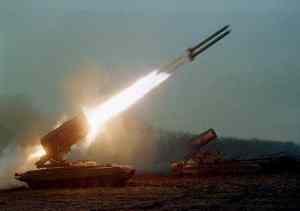 |
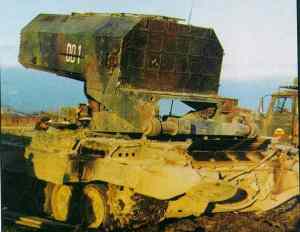 |
 |
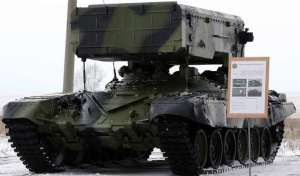 |
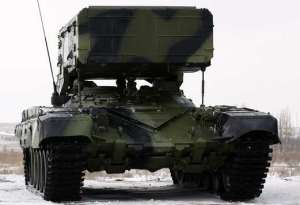 |
 |
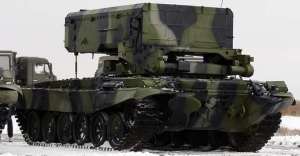 |
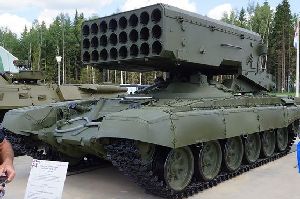 |
